Voltage Harmonic Suppression by Means of Grid-Connected Converters Using only Local Measurements †
Abstract
:1. Introduction
2. Proposed Control Scheme and System Modelling
2.1. Structure of the Proposed Control Scheme
2.2. Current Control
2.3. Voltage Support
2.4. System Open-Loop Model
2.5. System Closed-Loop Model
3. Model Analysis for Harmonic Attenuation Effect Study
3.1. Fundamental Converter Output Current Regulation: , and
3.2. Add-on Voltage Harmonic Attenuation:
3.3. Sensitivity to Grid Frequency Estimation Error
3.4. Compensation for Grid Frequency Estimation Error:
3.5. Discussion on the Application under a Grid with Frequency Change
4. Experimental Investigation
4.1. Setup Description
4.2. Discrete-Time Implementation
4.3. Impact of Non-Linear Load on the Local Voltage Quality
4.4. Validation of Voltage Support
4.5. Validation of Fundamental Current Regulation
4.6. Sensitivity to Grid Frequency Estimation Error
4.7. Compensation for Grid Frequency Estimation Error
5. Discussion
6. Conclusions
Author Contributions
Funding
Conflicts of Interest
Abbreviations
| APF | Active power filter |
| DG | Distributed generators |
| IMP | Internal model principle |
| PR | Proportional resonance |
| DC | Direct current |
| PLL | Phase lock loop |
| pcc | Point of common connection |
| FFT | Fast Fourier Transformation |
| ac | alternating current |
References
- Hossain, M.A.; Pota, H.R.; Issa, W.; Hossain, M.J. Overview of AC microgrid controls with inverter-interfaced generations. Energies 2017, 10, 1300. [Google Scholar] [CrossRef]
- Karimi-Ghartemani, M. Universal integrated synchronization and control for single-phase DC/AC converters. IEEE Trans. Power Electron. 2015, 30, 1544–1557. [Google Scholar] [CrossRef]
- Tareen, W.; Aamir, M.; Mekhilef, S.; Nakaoka, M.; Seyedmahmoudian, M.; Horan, B.; Memon, M.; Baig, N. Mitigation of power quality issues due to high penetration of renewable energy sources in electric grid systems using three-phase APF/STATCOM technologies: A review. Energies 2018, 11, 1491. [Google Scholar] [CrossRef]
- Javadi, A.; Hamadi, A.; Woodward, L.; Al-Haddad, K. Experimental Investigation on a hybrid series active power compensator to improve power quality of typical households. IEEE Trans. Ind. Electron. 2016, 63, 4849–4859. [Google Scholar] [CrossRef]
- Fang, J.; Xiao, G.; Yang, X.; Tang, Y. Parameter design of a novel series-parallel-resonant LCL filter for single-phase half-bridge active power filters. IEEE Trans. Power Electron. 2017, 32, 200–217. [Google Scholar] [CrossRef]
- Zhao, Q.; Ye, Y.; Xu, G.; Zhu, M. Improved repetitive control scheme for grid-connected inverter with frequency adaptation. IET Power Electron. 2016, 5, 883–890. [Google Scholar] [CrossRef]
- Almeida, P.M.D.; Duarte, J.L.; Ribeiro, P.F.; Barbosa, P.G. Repetitive controller for improving grid-connected photovoltaic systems. IET Power Electron. 2014, 7, 1466–1474. [Google Scholar] [CrossRef] [Green Version]
- Castilla, M.; Miret, J.; Matas, J.; Vicuna, L.G.D.; Guerrero, J.M. Control design guidelines for single-phase grid-connected photovoltaic inverters with damped resonant harmonic compensators. IEEE Trans. Ind. Electron. 2009, 56, 4492–4501. [Google Scholar] [CrossRef]
- Trinh, Q.N.; Lee, H.H. An enhanced grid current compensator for grid-connected distributed generation under nonlinear loads and grid voltage distortions. IEEE Trans. Ind. Electron. 2014, 61, 6528–6537. [Google Scholar] [CrossRef]
- Bonaldo, J.P.; Paredes, H.K.M.; Pomilio, J.A. Control of single-phase power converters connected to low-voltage distorted power systems with variable compensation objectives. IEEE Trans. Power Electron. 2016, 31, 2039–2052. [Google Scholar] [CrossRef]
- Chilipi, R.R.; Sayari, N.A.; Beig, A.R.; Hosani, K.A. A multitasking control algorithm for grid-connected inverters in distributed generation applications using adaptive noise cancellation filters. IEEE Trans. Energy Convers. 2016, 31, 714–727. [Google Scholar] [CrossRef]
- Chen, X.; Dai, K.; Xu, C.; Peng, L.; Zhang, Y. Harmonic compensation and resonance damping for SAPF with selective closed-loop regulation of terminal voltage. IET Power Electron. 2017, 10, 619–629. [Google Scholar] [CrossRef]
- Li, Y.W.; He, J. Distribution system harmonic compensation methods: an overview of DG-interfacing inverters. IEEE Ind. Electron. Mag. 2014, 8, 18–31. [Google Scholar] [CrossRef]
- Brusco, G.; Burgio, A.; Menniti, D.; Motta, M.; Pinnarelli, A.; Sorrentino, N. A repetitive-based control for a single-phase shunt active power filter for harmonic voltage compensation. In Proceedings of the 2016 IEEE 16th International Conference on Environment and Electrical Engineering (EEEIC), Florence, Italy, 7–10 June 2016. [Google Scholar]
- D’Arco, S.; Ochoa-Gimenez, M.; Piegari, L.; Tricoli, P. Harmonics and interharmonics compensation with active front-End converters based only on local voltage measurements. IEEE Trans. Ind. Electron. 2017, 64, 796–805. [Google Scholar] [CrossRef]
- Zhao, X.; Meng, L.; Xie, C.; Guerrero, J.M.; Wu, X.; Vasquez, J.C.; Savaghebi, M. A voltage feedback based harmonic compensation strategy for current-controlled converters. IEEE Trans. Ind. Appl. 2017, 99, 2616–2627. [Google Scholar] [CrossRef]
- Zhang, Y.; Hendrix, M.A.M.; Roes, M.G.L.; Duarte, J.L. Grid-connected converters with voltage support using only local measurements. In Proceedings of the IEEE 8th International Symposium on Power Electronics for Distributed Generation Systems (PEDG), Florianopolis, Brazil, 17–20 April 2017. [Google Scholar]
- Zhang, Y.; Roes, M.G.L.; Hendrix, M.A.M.; Duarte, J.L. Stability analysis of grid-connected converters with add-on voltage support functionality using repetitive control. In Proceedings of the IEEE 10th International Power Electronics and Motion Control Conference (IPEMC-ECCE Asia), Niigata, Japan, 20–24 May 2018. [Google Scholar]
- Francis, B.A.; Wonham, W.M. The internal model principle of control theory. Automatica 1976, 12, 457–465. [Google Scholar] [CrossRef]
- Oruganti, H.; Dash, S.; Nallaperumal, C.; Ramasamy, S.; Oruganti, H.; Dash, S.S.; Nallaperumal, C.; Ramasamy, S. A proportional resonant controller for suppressing resonance in grid tied multilevel inverter. Energies 2018, 11, 1024. [Google Scholar] [CrossRef]
- Yang, Y.; Zhou, K.; Blaabjerg, F. Enhancing the frequency adaptability of periodic current controllers with a fixed sampling rate for grid-connected power converters. IEEE Trans. Power Electron. 2016, 31, 7273–7285. [Google Scholar] [CrossRef]
- Mastromauro, R.A.; Liserre, M.; Kerekes, T.; Dell’Aquila, A. A single-phase voltage-controlled grid-connected photovoltaic system with power quality conditioner functionality. IEEE Trans. Ind. Electron. 2009, 56, 4436–4444. [Google Scholar] [CrossRef]
- Zhang, Y.; Hendrix, M.; Roes, M.G.L.; Duarte, J.; Lomonova, E. Voltage harmonics suppression add-on functionality without additional sensors for existing grid-connected inverters. In Proceedings of the 19th European Conference on Power Electronics and Applications (EPE’17 ECCE-Europe), Warsaw, Poland, 11–14 September 2017. [Google Scholar]
- Herrán, M.A.; Fischer, J.R.; González, S.A.; Judewicz, M.G.; Carugati, I.; Carrica, D.O. Repetitive control with adaptive sampling frequency for wind power generation systems. IEEE J. Emerg. Sel. Top. Power Electron. 2014, 2, 58–69. [Google Scholar] [CrossRef]
- Xiao, F.; Dong, L.; Li, L.; Liao, X. A frequency-fixed SOGI-based PLL for single-phase grid-connected converters. IEEE Trans. Power Electron. 2017, 32, 1713–1719. [Google Scholar] [CrossRef]
- Yepes, A.G.; Freijedo, F.D.; Lopez, O.; Doval-Gandoy, J. High-performance digital resonant controllers implemented with two integrators. IEEE Trans. Power Electron. 2011, 26, 563–576. [Google Scholar] [CrossRef]
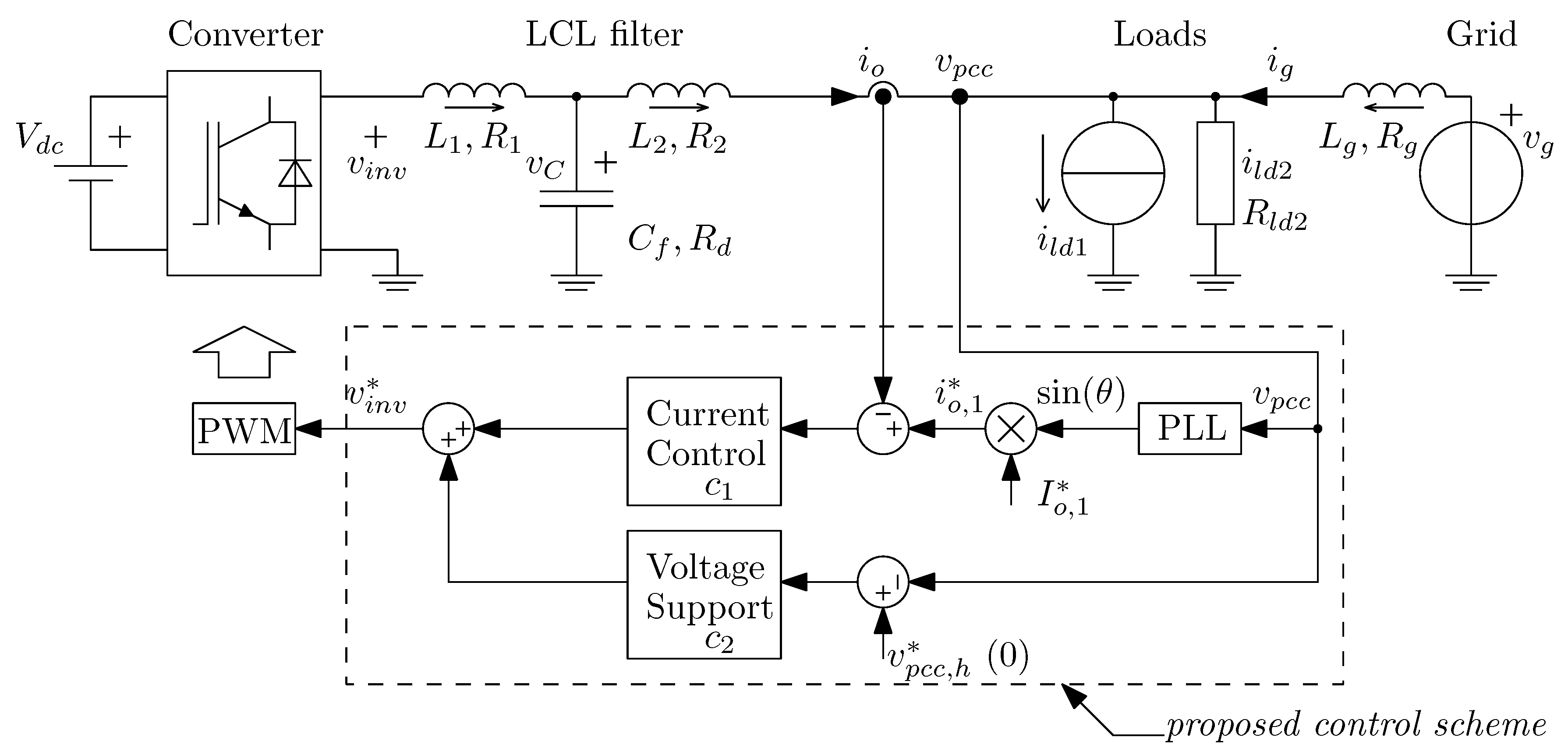
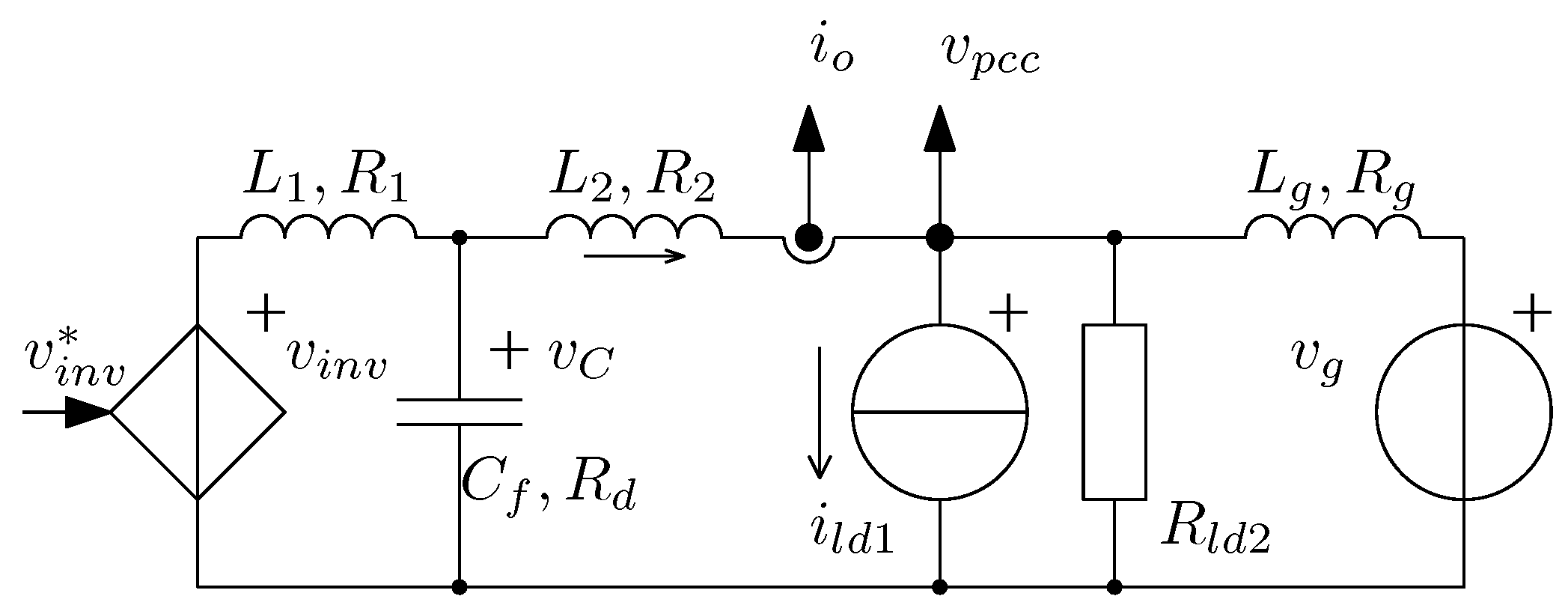
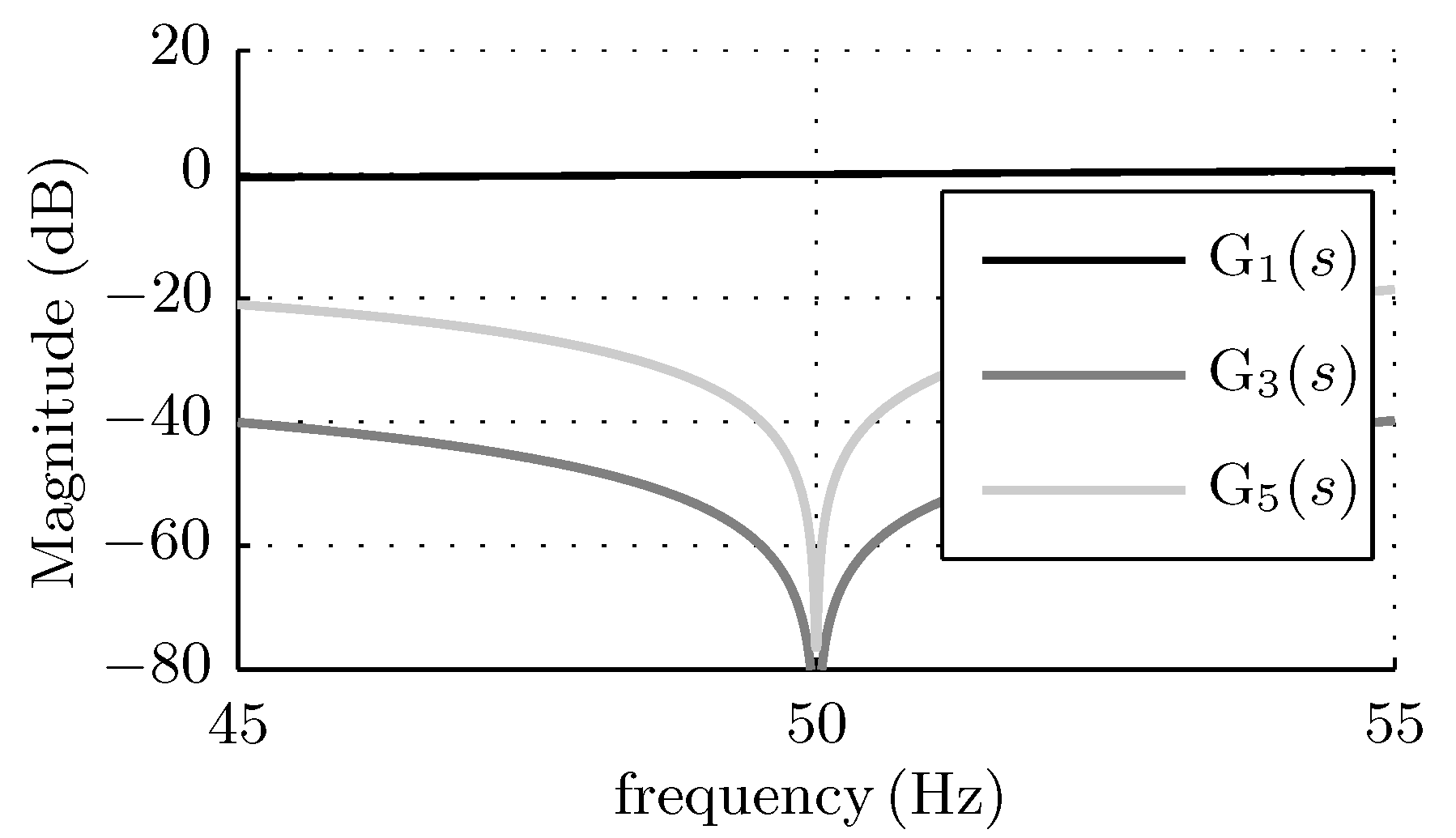
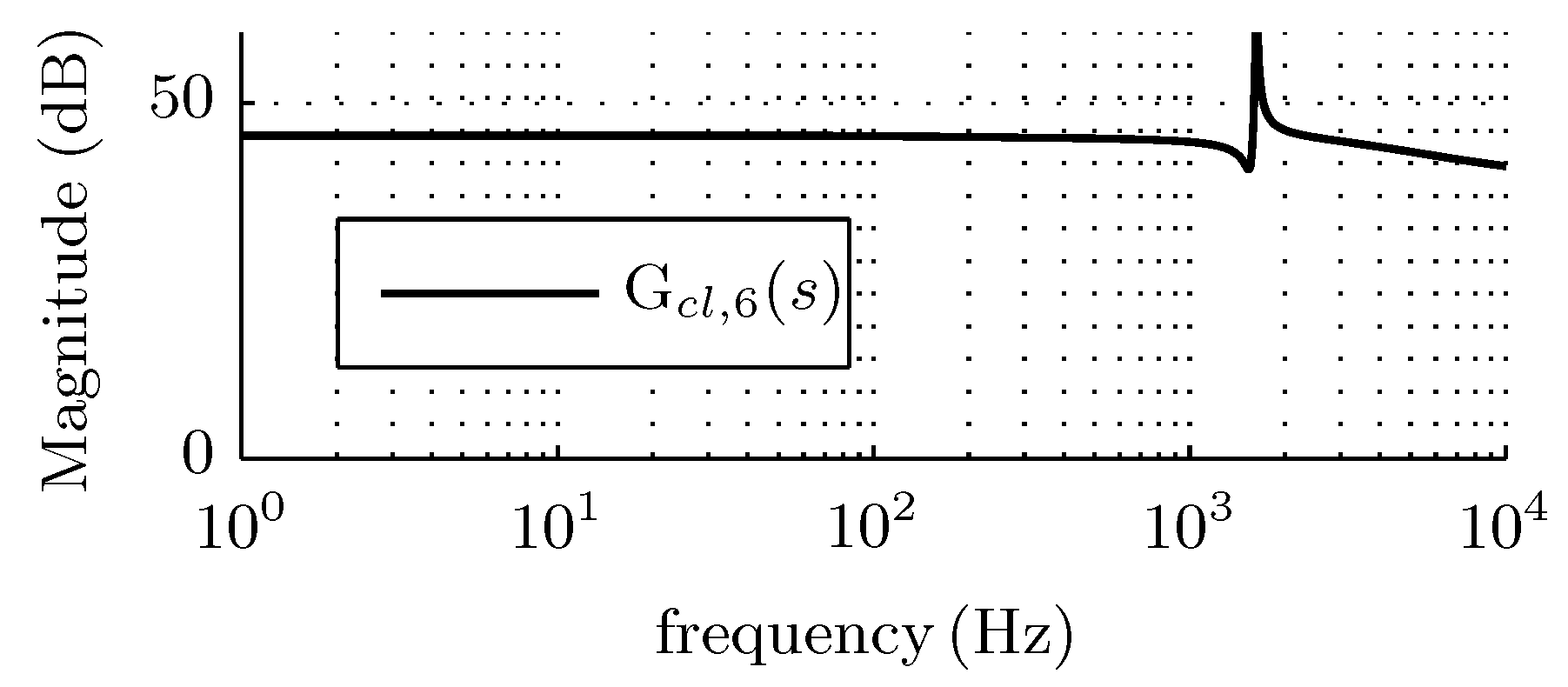
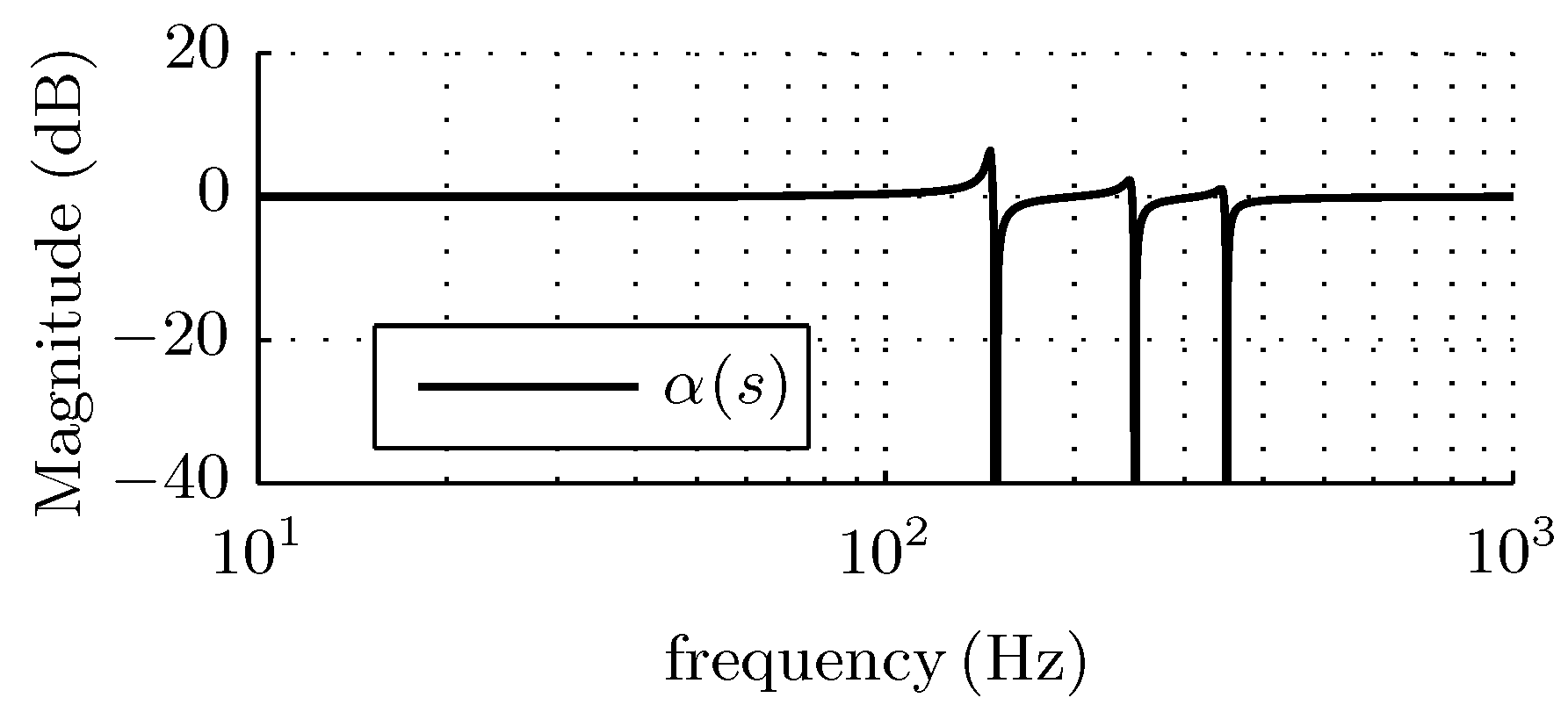
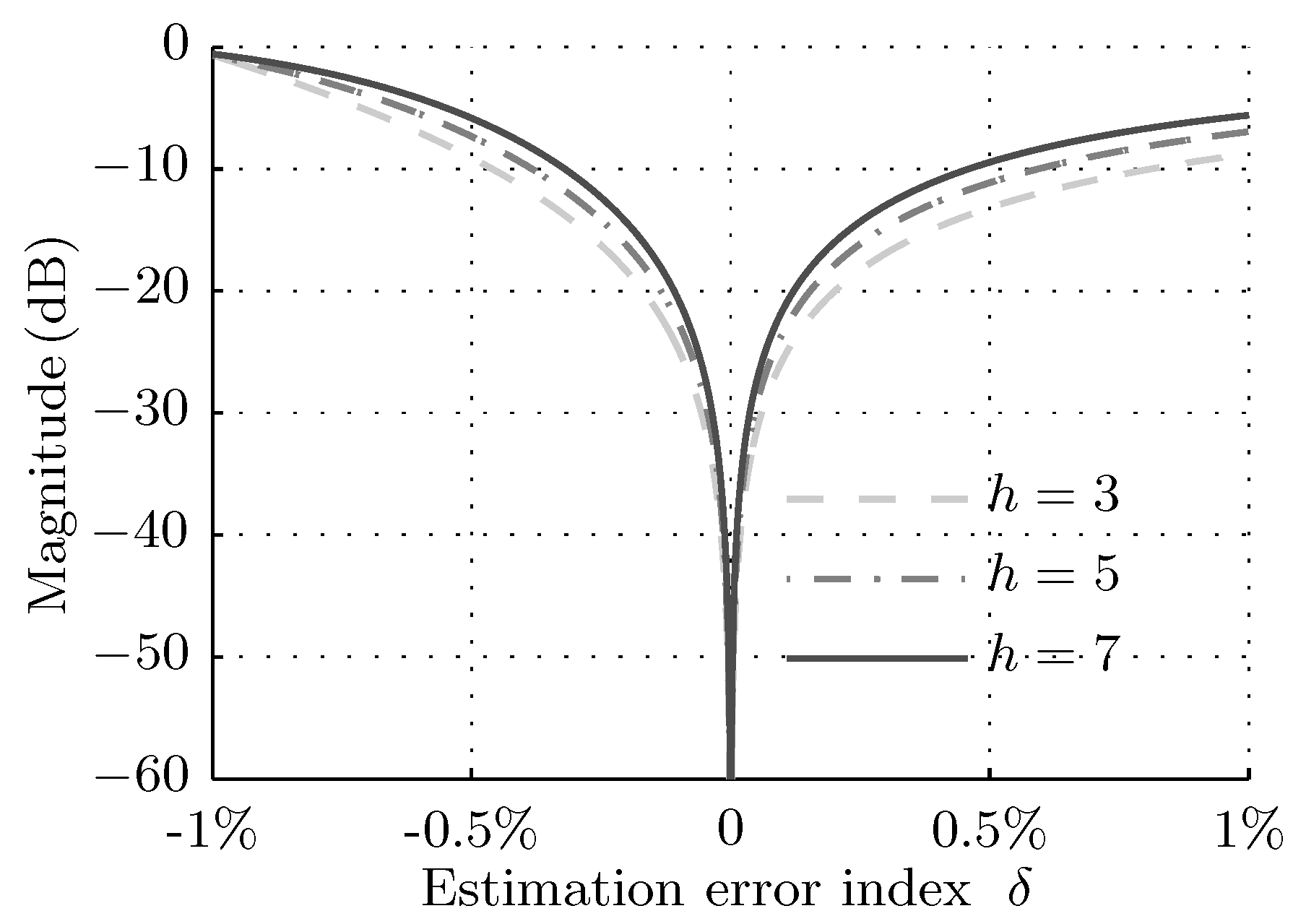
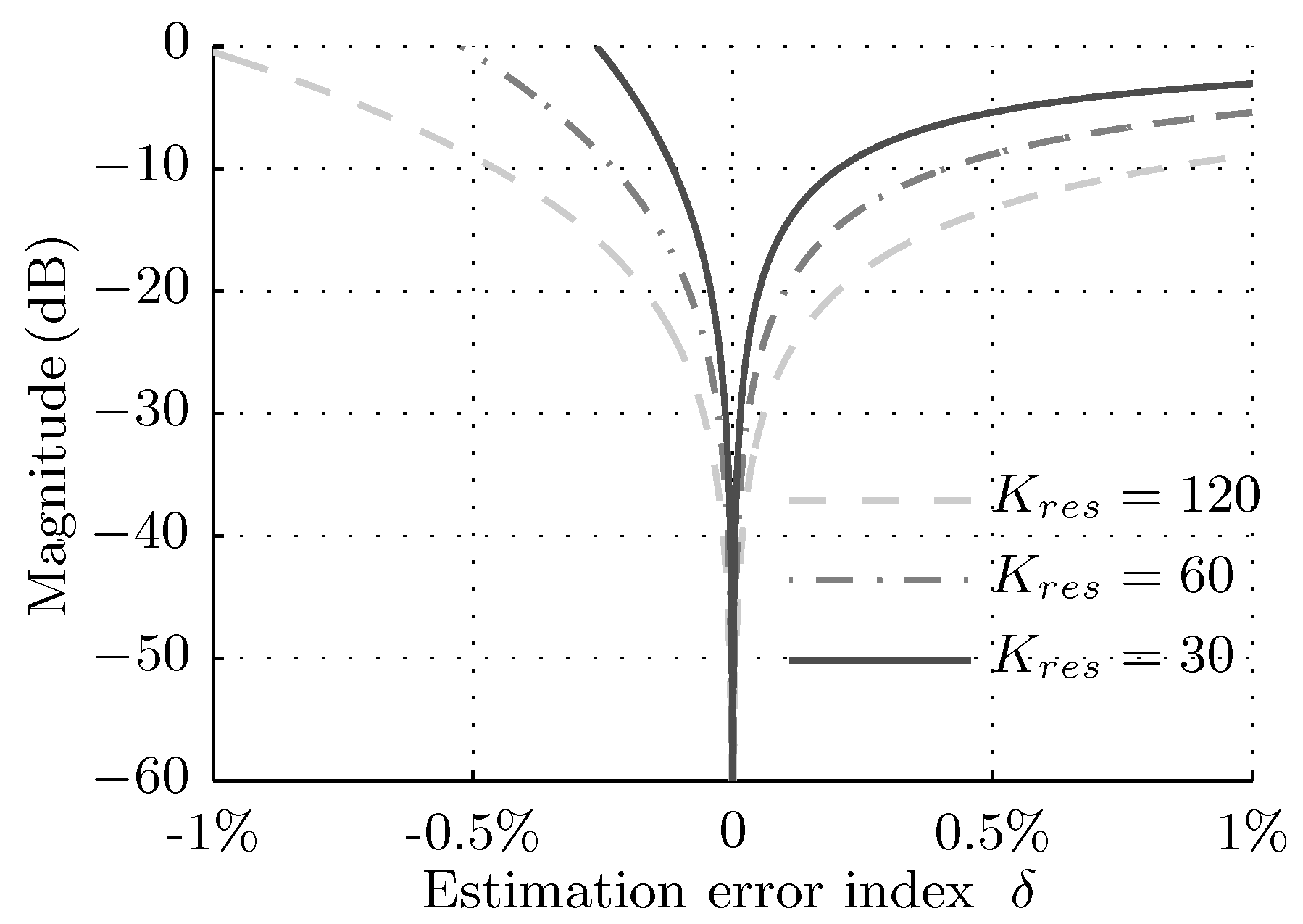

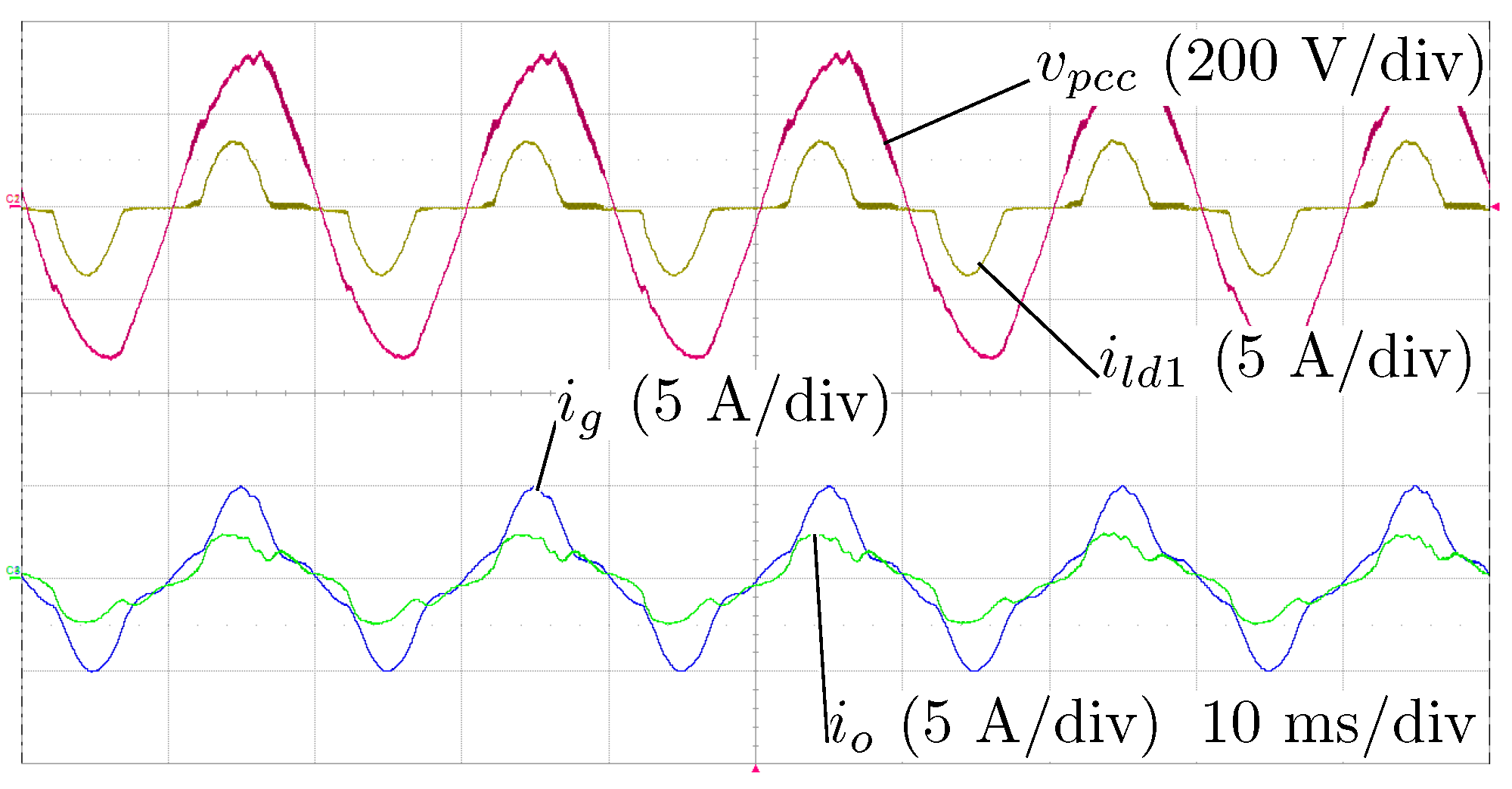


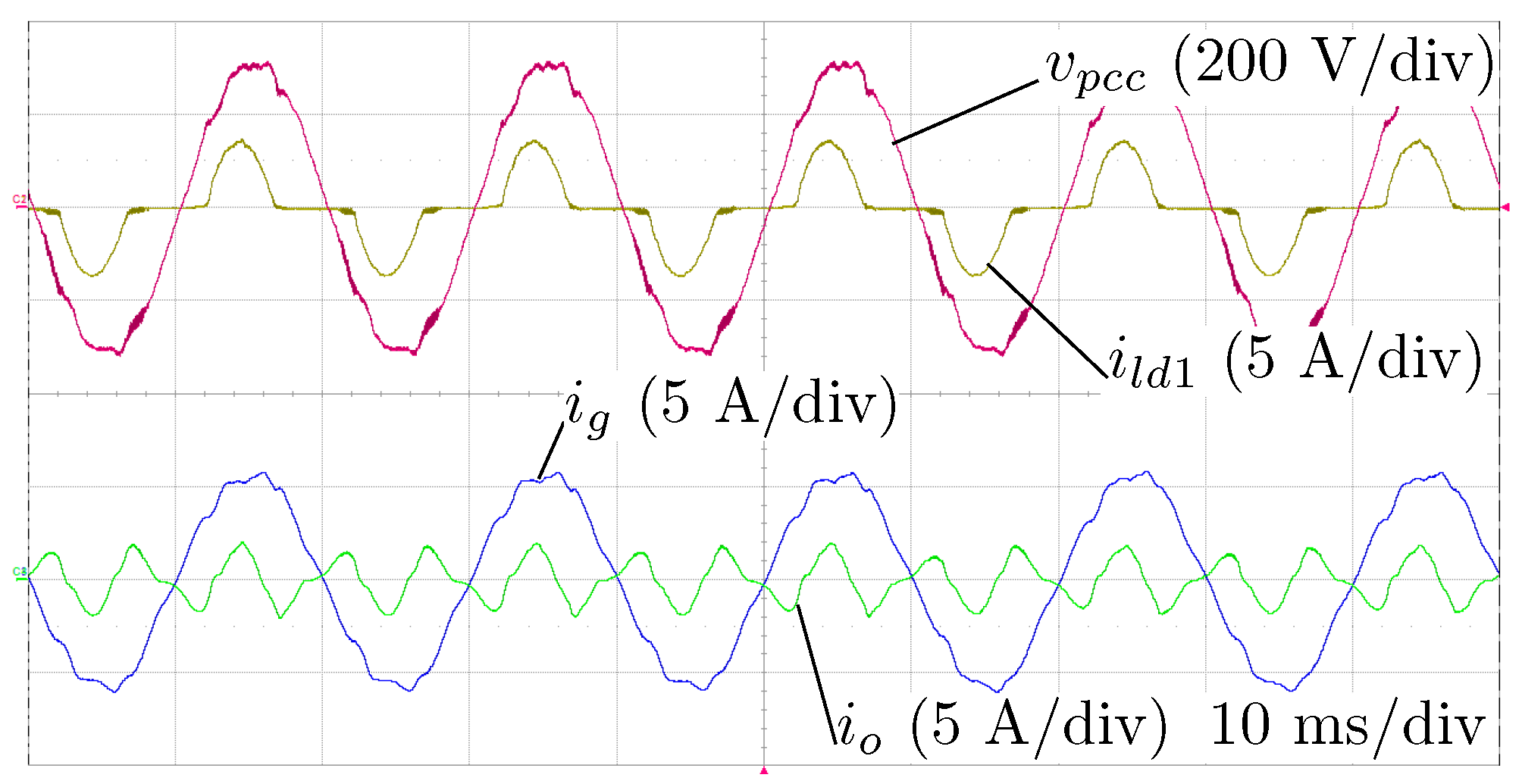
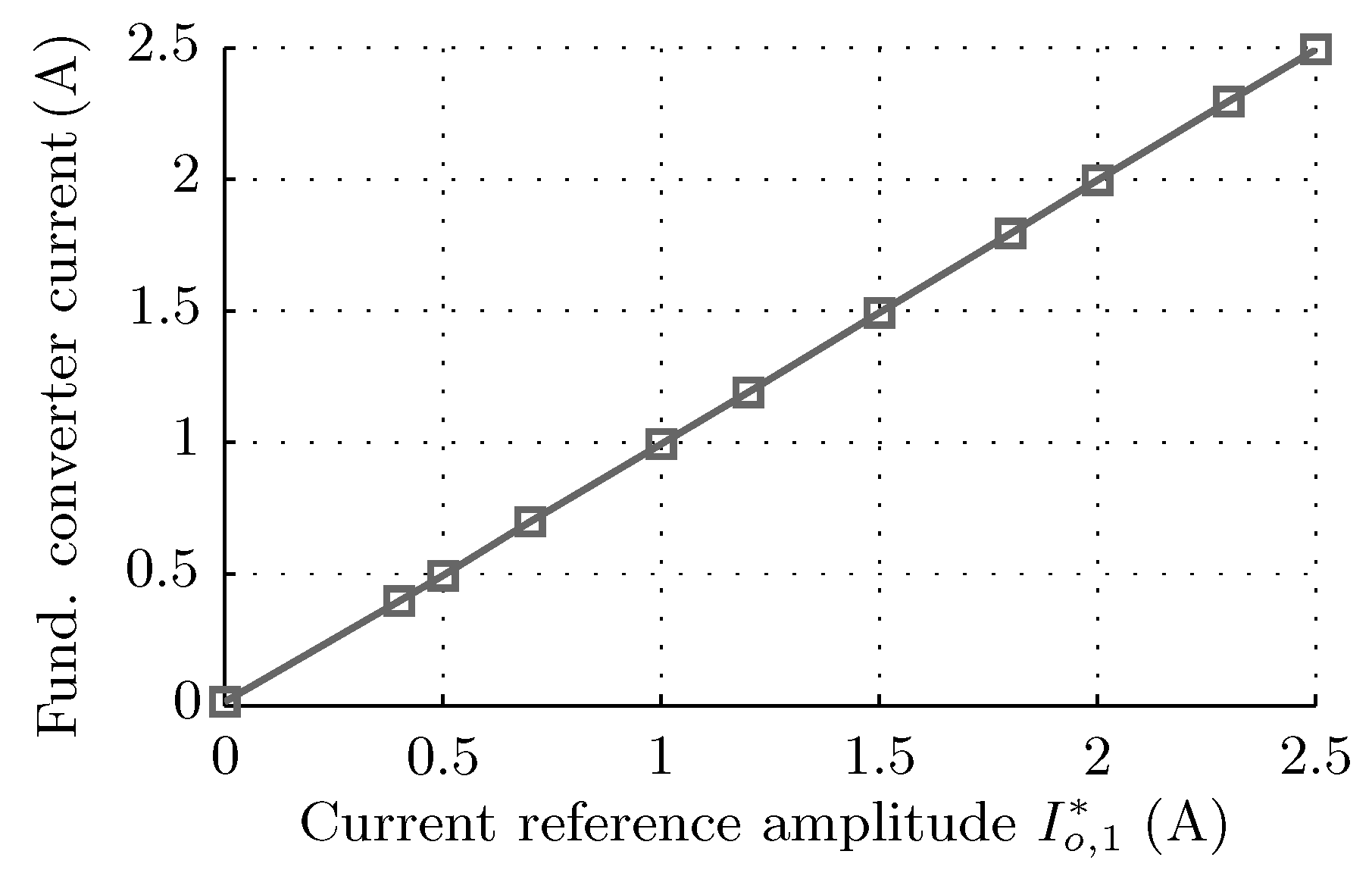
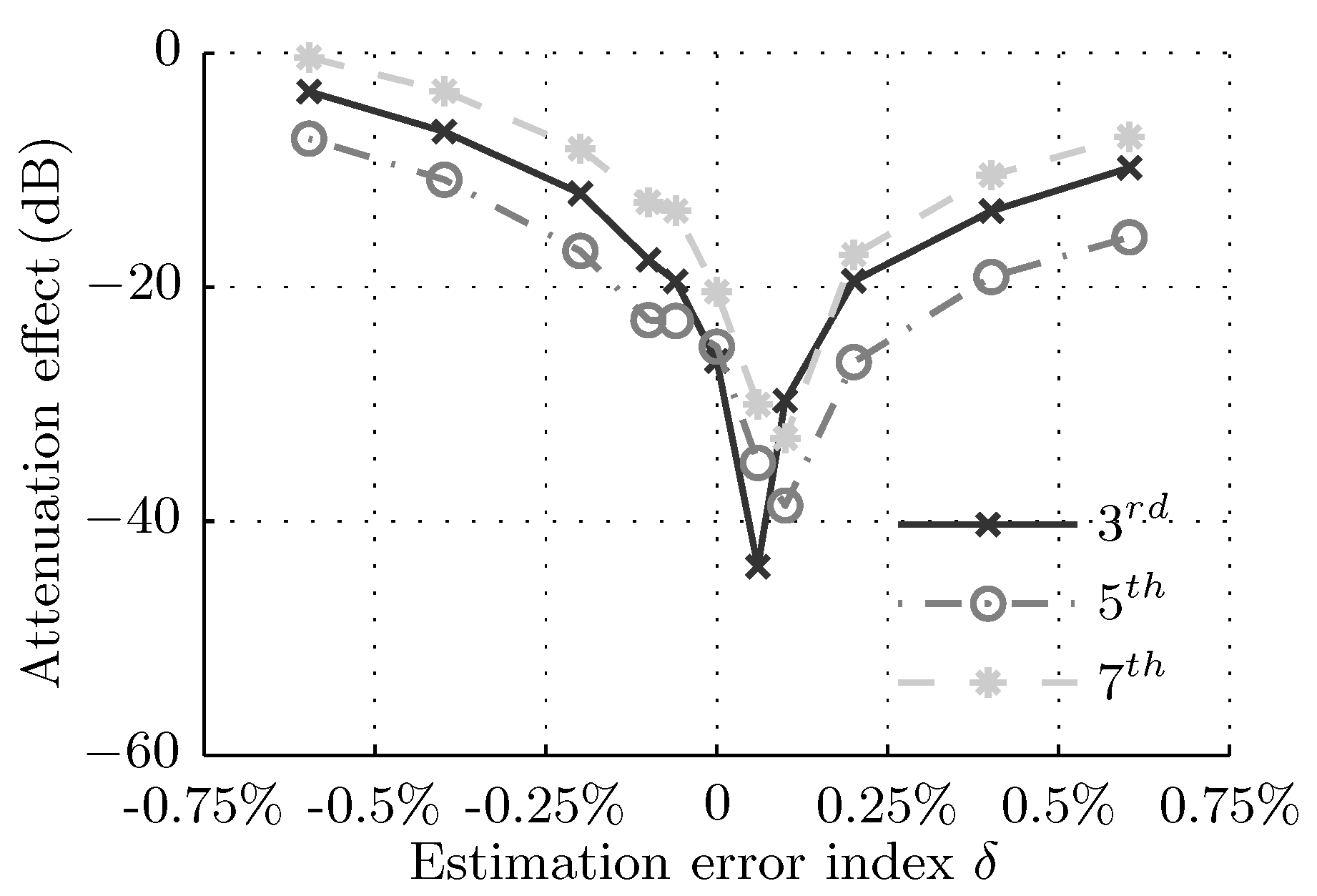
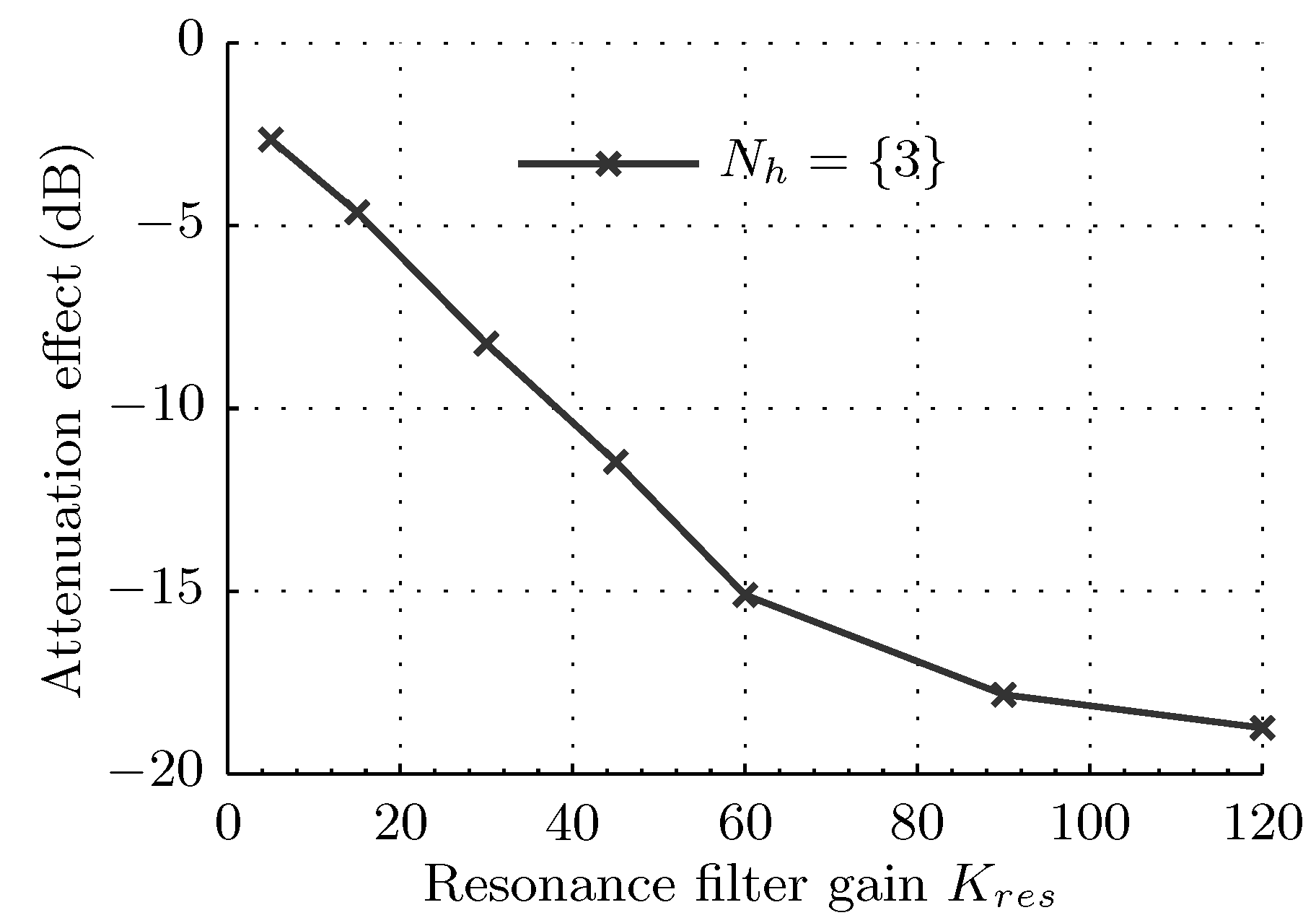
| Description | Symbol | Value |
|---|---|---|
| DC power supply voltage | ||
| Converter switching frequency | ||
| LCL filter | ||
| 0.2 | ||
| 0.2 | ||
| Linear load resistance | 94 | |
| Non-linear load Crest factor | 2 | |
| Non-linear load power factor | ||
| Non-linear load rms current | ||
| Grid rms voltage | ||
| Nominal grid frequency | ||
| Grid impedance | ||
| 0.4 |
| Description | Symbol | Value |
|---|---|---|
| (Estimated) grid frequency | ||
| Sampling frequency | ||
| Proportional resonance filter | 30 | |
| 6000 | ||
| Resonance filters | 120 | |
| Selective harmonic order | ||
| Amplitude of the desired fundamental output current |
© 2018 by the authors. Licensee MDPI, Basel, Switzerland. This article is an open access article distributed under the terms and conditions of the Creative Commons Attribution (CC BY) license (http://creativecommons.org/licenses/by/4.0/).
Share and Cite
Zhang, Y.; Roes, M.G.L.; Hendrix, M.A.M.; Duarte, J.L. Voltage Harmonic Suppression by Means of Grid-Connected Converters Using only Local Measurements. Energies 2018, 11, 2515. https://doi.org/10.3390/en11102515
Zhang Y, Roes MGL, Hendrix MAM, Duarte JL. Voltage Harmonic Suppression by Means of Grid-Connected Converters Using only Local Measurements. Energies. 2018; 11(10):2515. https://doi.org/10.3390/en11102515
Chicago/Turabian StyleZhang, Ya, Maurice G. L. Roes, Marcel A. M. Hendrix, and Jorge L. Duarte. 2018. "Voltage Harmonic Suppression by Means of Grid-Connected Converters Using only Local Measurements" Energies 11, no. 10: 2515. https://doi.org/10.3390/en11102515





